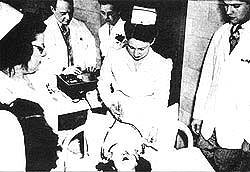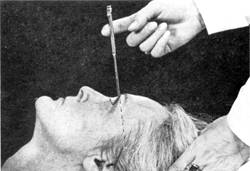
Electroshock treatment as it was
carried out in its early days,
without anaesthesia, use of
muscle relaxation drugs or added
supply of oxygen. Today all three
supporting measures are used
in connection with
electroshock treatment
Electroshock therapy
In 1935 treatment with shock therapy was introduced. Both insulin induced coma treatment and convulsion treatment were used. Convulsive shock was induced by injection of camphor or cardiazol.
Then in 1938 electroshock was introduced, following the Italian neurologist Cerletti having seen pigs being anaesthetized before slaughter. Electroshock treatments were originally carried out without anesthesia by using an electric shock device. In the museum exhibition you can see such a device, which was in use here at the hospital, from the 1940s to the early 1960s.
Today electroshock, now called electro stimulation, is given under general anesthesia, supplemented with muscle relaxing drugs. Electro stimulation is used more often in Denmark than in other countries. Some countries have almost ceased to use this kind of treatment. (See poster nb.18).

Lobotomy was also performed under
local anesthesia and carried out
through the patient's eye sockets.
Lobotomy
Around 1935 lobotomy was first used by the Portuguese neurologist Egaz Moniz. Holes were drilled into the patient’s skull and some of the neurological connections between the anterior lobe and the deeper brain were cut with a small knife.
This psychosurgical operation was generally accepted, especially in America, from where the procedure quickly reappeared in Europe. It was looked upon as the fulfilment of a long term desire for a remedy against very painful and permanent mental diseases such as schizophrenia, hallucinations, severe obsessive thoughts or actions and deep depression.
This type of surgery went out of use with the introduction of psychotropic drugs in 1954.

When performing lobotomy, incisions
are made into the skin in both
temporal regions. Then a hole
is drilled into the skull, so that
the leucotomet (a special surgical
knife for cutting into brain tissue)
can be inserted into the brain.
Lobotomy was also performed
through the patient’s eye sockets
and with only local anaesthesia
given to the patient.
Lobotomy brought into disrepute
The effect of lobotomy was later called into question. As seen in the treatment of schizophrenia, amongst other conditions, the effect was questionable. Although the surgery relieved the patients of otherwise resistant suffering, especially continuing compulsions, many also became callous and apathetic.
This crude form of lobotomy stopped being used in the fifties.
In the 1960s attempts were made with a more refined type of lobotomy, the so called stereotaxi. By scanning the brain, attempts were made to discover any disease in the brain. Subsequently surgical procedures were performed on these areas of the brain by means of a “Gamma Knife” (a radioactive ray). Up until the 70s this new method was in use in Denmark. In rare cases, this procedure was used as treatment for self-destructive mentally ill patients. In America, Canada and Sweden the procedure is still in use in treating patients with extremely agonizing obsessive compulsive disorder.
Today lobotomy has fallen into disrepute as an irreversible procedure to the brain and an intervention into a person’s personality. A number of patients who have had this operation have later received compensation.
„Survival of the fittest“
The great scientific discoveries, which increased the knowledge about mental illnesses, brought not only progress.
Under the influence of Darwin’s teachings on natural selection, in the early twentieth century eugenicists considered the insane and mentally ill to be carriers of hereditary degenerative illnesses. Eugenics almost achieved the status of a science, and it became acceptable to discuss the question, what is worthy of living
Mass sterilization of mentally ill people became an accepted procedure performed to prevent the dreaded “degeneration”. Time would show that efforts to prevent this “degeneration” would scale into horrific proportions.
Brutalization results in loss of civilization
World War I, from 1914-18 and especially the war fought from the trenches gave rise to an extreme brutalization in society. Especially in Germany thousands of mentally ill patients were starved resulting in death for a lot of them. They were looked upon as “useless eating creatures”. All resources were to go to the front.
Later in 1933 Adolf Hitler came to power and the brutalization continued.

This monument is placed outside the
asylum in Weilmünster in memory
of the 278 women and men who,
between 1934 and 1939, were
forcefully sterilized or forced to
have a vasectomy. In memory is
also mentioned the 3000 patients who
were taken to the asylum in
Hadamar were they were killed.
The Jewish patients
from the asylum were likewise
taken away and killed.
The exterminations set into place by the Nazis.
In 1939-41, by order from Hitler, a very systematic and effective extermination program was set into place. It was called Gnadentot and approximately 75.000 mentally ill or insane patients were killed, most of them by gas.
German doctors singled out the “unwertvolle” (worthless) and by that condemned them to a certain death. Because of pressure and protest, from the churches and others, this program was brought to an end in August 1941, but the murder of mentally ill and mentally handicapped patients continued at the asylums. The patients were systematically malnourished and medically overdosed and approximately 250,000 patients were deprived of their life. This went on until the German surrender in May 1945.




